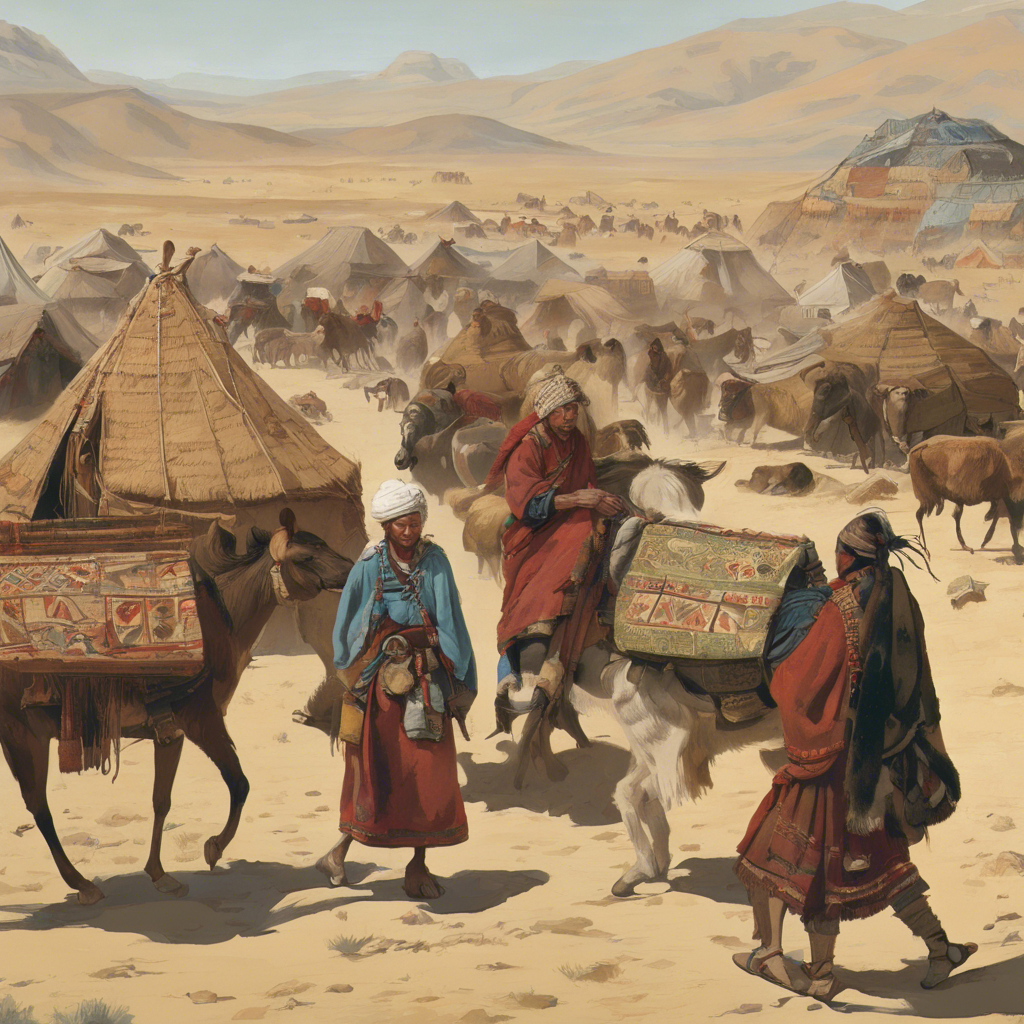The Secret Lives of Nomads: Books that Unveil the Hidden World of Nomadic Cultures
Ever nestled in the comfort of your home with a tome that traverses the vast reaches of the globe? Literature is a window to the lives of those we may never meet, and the places we may never get the opportunity to explore. This article takes you through an adventurous literary expedition, uncovering the fascinating reality of global nomadic cultures that have confounded and captivated humanity throughout the ages. From the expansive Saharan dunes to the daunting Siberian tundra, let’s embark on this journey to understand these distinct lifestyles, their joys, challenges, and unending quests for a sense of belonging. So buckle up, and prepare to be absolutely enthralled as we ride the rough and rugged terrains through the boundless landscapes of literature.
The nomadic existence, although elusive to most of us, has consistently been a reservoir of intriguing stories yearning to be told. It’s invariably a lifestyle of constant change, relentless resilience, and awe-inspiring adaptability. These captivating narratives bring you face-to-face with the intricacies of their everyday life, their deep-seated traditions, and the unsung heroes of these mobile communities. Through these literary works, we wish to map the trajectory of these nomadic cultures, their depiction across different genres, and the profound impact they’ve had on our collective cultural ethos.
“Stories are the creative conversion of life itself into a more powerful, clearer, more meaningful experience. They are the currency of human contact.” – Robert McKee
This exploration of nomadic narratives isn’t just about the stories themselves—it is about the interaction between words and culture, the ink shaping our understanding of the world and the people who inhabit it. Books are not just written; they are lived, experienced, and remembered. They help us comprehend our shared human experience through diverse cultural lenses, fostering empathy and nourishing our imaginative capabilities. Grab a cup of your favorite beverage, turn on your reading light, and journey with us through these unique lifestyles and untold stories of various nomadic cultures across the globe through the lens of literature.
Saga of the Wandering Tribes: Stories Yet to be Told
As you delve into the rich tapestry of literature concerning diverse nomadic cultures, one cannot help but be intrigued by the untold stories waiting to be discovered. The rugged elusiveness of these communities often burrow deeply into a plethora of human experiences rarely known or seen from the outside.
Books like Robyn Davidson’s “Tracks” mirrors the essence of solitary nomadic existence in the Australian outback, offering you an intimate window into raw human survival and individual fortitude. Meanwhile, Jon Krakauer’s “Into The Wild” offers a chilling account of an urban nomad who abandons societal norms to roam the wilderness of Alaska—giving you a glimpse of how a seemingly idyllic lifestyle can unfurl into a tragic survival story.
Fascinatingly, these lifestyles are often not born out of choice, but necessity, with the trials and tribulations inextricably linked to the patterns of the natural world. This life, in its continuous ebb and flow, can be traced back to millennial old traditions, some of which unfortunately only exist in the fading pages of obscure texts.
Murmurs of these hidden histories can be found tucked between the folds of Ryszard Kapuściński’s “The Shadow of the Sun”. This seminal piece uses insightful anecdotes and stirring narratives about African tribes to paint the picture of life’s ephemeral quality in the face of constant motion.
So, as you embark on this literary journey, remember how it allows you to travel into the realm of the unknown and brings you face-to-face with an existential reality that remains largely invisible in mainstream dialogues. This exploration of the nomadic saga through literature prompts unparalleled curiosity and awe, enabling you to transcend geographical borders and engage deeply with the nomadic existence, even from the comfort of your reading nook.

Wandering the World: Books Exploring the Global Nomadic Experience
Immerse yourself in a world of sight and sound, scenery and soulful stories that bring the nomadic experience to life.
Tracks: A Woman’s Solo Trek Across 1700 Miles of Australian Outback by Robyn Davidson lends a firsthand experience of a woman’s audacious trek across the vast landscapes of Australia with only four camels and a dog for company. Innocuously documenting a self-assigned journey, this read exposes the raw and authentic experiences of what it means to be a nomad in a less traversed part of the world.
On a similar line, A Fortune-Teller Told Me: Earthbound Travels in the Far East by Tiziano Terzani tells the tale of a man forbidden to fly by a fortune teller, compelling him to traverse the land of Asia. The end product? A richly woven fabric of encounters with various nomads and the wisdom they impart.
Ernest Hemingway’s The Sun Also Rises is a classic tale of a group of American and British expatriates as they wander through France and Spain. Reflective of the Lost Generation—those who served in World War I and became disillusioned—this masterpiece speaks not just of physical journeys, but of emotional passage etched in time.
Lastly, turn to Patrick Leigh Fermor’s A Time of Gifts for an intoxicating reading adventure. Following Fermor’s journey on foot from the Hook of Holland to Constantinople in 1933, this book uncovers the rich history, varied cultures, and charming idiosyncrasies that are unique to nomadic existence.
These literary pieces are but a few in a sea of narratives that chronicle the unique nomadic lifestyle. They remind us that there is much to learn from the resilience and adaptability of those constantly on the move, and even more so from their often untold stories.
Life on the Move: Portrayal of Nomadic Existence in Literature
Seamlessly transitioned from the constraints of settled societies, the nomadic lifestyles, illustrated with prowess in literature, spark a unique allure that resonates with our innate sense of freedom. Such portrayal leaves a profound imprint on our understanding of human society, its adaptability, and the sheer diversity of existences that it encompasses.
As enchanting as the concept might sound, nomadic existence isn’t just about the freedom to roam or the romance of pristine landscapes; instead, it’s an intricate tapestry interweaving survival, resilience, and community. Every story, every narrative, carries its unique share of thrills, adventures, hardships, and life-changing decisions that literally and metaphorically set courses for generations to follow.
Literature serves as a powerful medium to encompass the vast expanse of the nomadic life, from the vast deserts, where the wind writes tales in the sand dunes, to the high plateaus where the icy winds carry stories of survival. Reflective accounts of pastoral communities, like the Maasai of East Africa or the Mongolian herders, offer us glimpses into their vibrant cultures, rich traditions, and age-old wisdom passed down through generations.
Books like Bruce Chatwin’s “Nomad Invasions” and Robyn Davidson’s “Tracks” are mesmerizing symphonies that sing about the nomadic experience in all its raw honesty. They capture the spirit of nomadic tribes in their words, painting vivid images that often evoke a profound sense of empathy, intrigue, and fascination in the readers.
In literary representation, the nomadic lifestyle doesn’t merely exist; it lives, breathing in the rhythm of the migratory herds, the seasonal shifts, the changing constellations, and the untamed rhythms of nature itself. It’s not just a way of life narrated through pages – it’s an experience that alters perspectives, broadens horizons, and immerses one completely into the essence of human existence in tandem with the natural world.
To truly understand and appreciate the unique nuances of nomadic cultures is to take a deep dive into these captivating stories. To comprehend the constant flux they live in, the harmony they strike with nature, and their perennial odyssey in pursuit of an eternal quest native to mankind – belonging and survival.
Silent Stories: Books Capturing the Unheard Voices of Nomadic Tribes
Reflecting the oral traditions and rich histories of nomadic tribes, literature can capture their unique voices with authenticity, bringing unseen and unheard experiences to the forefront. While some of these stories are passed down through generations, others are penned by empathetic observers. Let’s embark on a journey where the written word brings the word of mouth to life.
“The Last Nomad” by Shunu Sen is a profound tale of the Lambadi tribe of Rajasthan. Each page of this book yields insights into the age-old customs, nomadic lifestyle, and which emphasizes the tribe’s adaptability amidst the harsh desert environment. Sen’s empathetic storytelling gifts the reader an authentic glance into the resilient spirit and vibrant culture of this tribe. The seasoned slant of narrative takes you on an odyssey, where the pages of the book transform into the sandy dunes of Rajasthan.
When discussing the Silent Stories of nomadic tribes, “The Taiga’s Echo” by Dmitry Shukhov is a must-read. This remarkable work, rooted in the author’s intense study, revolves around the enigmatic existence of the Siberian nomads. Capturing the strenuous life in the freezing temperatures, the pages echo their survival instincts, solidarity, and the intrinsic bond they share with nature.
Finally, “Under the Open Sky – A Tale of the Sea Gypsies” by Emma S. Garcia is a compelling narrative that embodies the seafaring tribes in Southeast Asia’s maritime nomadic life. Garcia vividly portrays their life in both beautiful and brutal brushstrokes, highlighting how home, for them, is where the tide takes them. As you flip through the pages, you’ll feel the salty sea breeze on your face, and hear the rhythmic splash of oars meeting oceans.
There you have it, my fellow literature enthusiasts — a discovery into the world of the silent stories of nomadic tribes, as expressed through the power of the written word. Each recounted tale is a passport to their realm, painted with cultural nuances and flavored with native dialects. These books don’t just tell stories; they build bridges between disparate worlds, connecting you with the unique lifestyles of these wanderers.
Nomadic Narratives: Books that Bring the Nomad’s Journey to Life
Imagine yourself in an expansive desert, the winds gently rustling your tent flaps in the middle of the night, or perhaps curled up in an igloo under the brilliant display of the Northern Lights. The life of a nomad isn’t just about wandering or moving around aimlessly, it’s a dance with nature, an appreciation of the impermanence of life, and an embodiment of freedom. This spirit, this soul-bearing reality, is encapsulated strikingly in a number of literary works.
Let’s plunge into a few distinct books that draw you into the nomadic lifestyle and make you feel part of it, even if just for a while.
The Horse Boy by Rupert Isaacson narrates an incredible journey of a father and his autistic son on horseback through the Mongolian steppe. Isaacson entwines the raw, harsh reality of nomadic life with the transformative power of love, and gauchos, the nomadic horsemen come alive in his narrative.
T.E. Lawrence’s Seven Pillars of Wisdom, on the other hand, paints a vivid picture of the nomadic Bedouin tribes of Arabia. This book, more than just a military memoir of the Arab Revolt during World War I, delves deep into the psyche and culture of the Bedouins, capturing the constant flux of their desert existence.
Lastly, Robyn Davidson’s Tracks is a captivating memoir that chronicles her journey across the Australian outback with just four camels and her trusty dog for company. The sweeping, uninhabited landscapes she traverses bring to light the beauty and the isolation that comes with nomadic life.
These books harness the power of vivid portrayal, allowing us to experience the incredibly diverse lives that nomads lead. Through them, we’re invited to step into the nomad’s shoes and accompany them on their journey, forever transformed by their unique perspective on the world.
Conclusion
Our voyage through the widely dispersed world of nomadic cultures, narrated by the powerful voices of literature, brings us to the place where the lines in the sand converge – understanding and empathy. By delving into the works of proficient authors who have deftly passed down the stories of these wandering tribes, we bear witness to the hardships and magnificence of their nomadic lifestyle.
There’s an inherent excitement in learning about the colorful and rich culture of these nomads, a reflection of their unique bond with the Earth and its elements. Their extraordinary communal existence, based on movement and adaptation, offers us glimpses of a lifestyle wonderfully different from our more urbanized modes of life.
While we’re left in awe of the resilience and adaptability of these tribes, we are also reminded of the challenges and sometimes harsh realities faced by nomadic societies. The tales of struggle, survival, and perseverance captured in these books invariably ignite an appreciation for the indomitable spirit of these tribes.
Although our guide has been literature, the journey continues beyond the written word. These stories inspire us, the readers, to explore more, learn more, and understand more about these nomadic cultures. Every book we crack open leads us to a deeper appreciation and respect for the remarkable variety of human experience.
So, next time you’re in a bookshop or browsing an online store, why not search for a compelling narrative about a nomadic culture? Let’s continue learning about these fascinating societies and remember, every page turned is a step further in our quest to discover the untold stories of our world.







